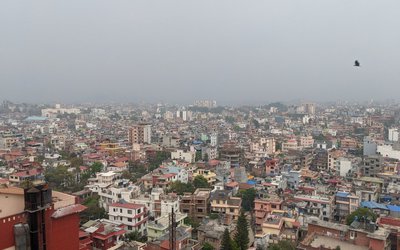Sajan Shrestha, his daughter Anisha and Bir Bahadur Majhi were killed when the dilapidated wall on the southern premises of the British Embassy fell on them. They were among the nine killed in Nepal by the earthquake of September 18, 2011.
Although there was a huge loss of infrastructure like school buildings and individual houses, the human casualties were nominal. When the quake hit the valley, many feared that it devastated the country. Their anticipation was proved wrong. This time, the loss was far less than that during the quake of 1988.
An earthquake measuring 6.9 on the Richter scale rocked the Himalayan region with its epicenter bordering north India and Nepal at 6:25 pm Nepali time on that Sunday. The epicenter was located 64 km north-west of Gangtok, capital of Sikkim, 133km from Namche Bazar in Nepal, and 40 km from Yadong county in Tibet, China. Aftershocks measuring 6.1 and 5.3 on the Richter scale were also felt around Sikkim 20 minutes after the earthquake.
The Trauma
Hem Nath Poudel, a resident of Dokhu-2 in Taplejung, and his family members spent nights in the open after the earthquake destroyed their house. Poudel, a disabled, set up a ‘kitchen’ near a boulder close by his quake-ravaged house.
“I was unable to go to the district headquarters all by myself, thanks to the disability,” he said.
He said neither rescuers nor government employees reached the village to inquire about the situation and provide relief materials.
There are scores of other people in Dokhu, its adjoining VDCs and various eastern districts close to the epicenter in the northern Indian state of Sikkim, who received relief five days after quake.
Chief District Officer Devraj Dhakal said, “We sent a relief team to the remote VDC (where Poudel lives) within a couple of days despite the rain.”
Current reports from Nepal Red Cross Society (NRCS) district chapters reveal that there were nine people dead and 89 injured and over 12,000 people affected across 17 districts. Structural damage to nearly 2,000 houses left over 1,213 families displaced (more than 7,278 people). They are frightened to return to their damaged homes. It is expected that the true scale of damage and number of displaced will increase in the coming days as more isolated areas are reached. Exacerbating the situation, monsoon rains and landslides in the region are affecting access.
The Government of Nepal's National Emergency Operations Centre (NEOC) has been activated and the District Disaster Relief Committees (DDRC) are convening meetings in affected district headquarters to ensure effective and coordinated response activities. The NRCS district chapters are represented in the DDRCs and will feed back information they have gathered as well as identify areas where there may be gaps in assistance needed.
The death toll from the earthquake in India has reached 83, leaving 200 people injured. Besides the loss to human lives, over 15,000 houses were razed to the ground and more than 100,000 were partially damaged.
Similarly, the earthquake affected 13 counties in Shigatse city of Tibet, China. Seven people were killed and 37 were injured. A total of 1,000 houses are reported to have collapsed during the earthquake. According to a report from the Bhutan Department of Disaster Management, the earthquake has caused one death, injured 16, and damaged about 4,000 houses.
“I cannot say right now about the exact damage as the ministry is collecting the data,” Minister of Home Affairs Bijaya Kumar Gachchhadar told New Spotlight.
“What I can say now is that the destruction was nominal because of our preparedness and level of awareness,” he said.
As Nepal lies in seismically active zone, it is natural to experience one or other quake from time to time. An earthquake occurred in 1988 near the Indian border, affecting much of northern Bihar. The magnitude 6.8 earthquake shook the region on August 21, 1988, killing about 1004 persons in India and 722 in Nepal and injuring more than 16,000.
“This is a wake-up call for many, for all those people who are indifferent to earthquakes,” said Amod Mani Dixit, executive director of Nepal’s National Society for Earthquake Technology-Nepal (NSET). “I am happy that the earthquake took place, though I am sorry for the loss of lives. I feel earthquakes are being forgotten. Now they are saying, ‘don’t forget quakes’.”
The main affected districts included Sankhuwasabha, Taplejung, Ilam, Dhankuta, Panchthar, Sunsari, and Okhaldhunga in the eastern region, and Bhaktapur in the central region, Nepal’s National Emergency Operation Centre within the Ministry of Home Affairs reported.
“This generation has never experienced an earthquake like this before,” said Umesh Prasad Dhakal, executive director of the Nepal Red Cross Society (NRC), while calling for increased earthquake preparedness and awareness.
Kathmandu valley is facing a high risk. “At the moment we are not very sure whether or not this will be repeated,” said Rita Dhakal, humanitarian affairs specialist with the UN Office for the Coordination of Humanitarian Affairs (OCHA). “Regardless, this is a signal for Nepal to be prepared.”
Over 16 major earthquakes have struck Nepal since 1223, the last occurring in 1988, according to the 2009 Nepal Disaster Report by the government of Nepal and the Disaster Preparedness Network-Nepal.
Valley’s apartment buildings that did not follow the building codes are the most vulnerable. In case of another quake, no tall building will survive. Experts argue that all the tall buildings constructed in the valley are unsafe to live.
"There are regulations but they are not followed," says Suresh Prakash Acharya, a high-ranking official, at the Ministry of Physical Planning and Works, in charge of urban development.
Kathmandu, which sprawls over the soft sediment of an ancient lakebed and is surrounded by mountains, is more vulnerable generally. This deadly combination of vulnerable buildings and geology can magnify seismic hazards by ten times, says Brian Tucker, president of GeoHazards International. A 2001 study by the California-based NGO ranked Kathmandu the most vulnerable to damage by a major earthquake among twenty high-risk cities it assessed (Tehran, Istanbul and parts of Indonesia also sit atop many seismologists' watch-lists).
Despite an unprecedented building boom in the latest times, the safety aspect has always remained ignored. Officials of Department of Urban Development and Building Construction (DUDBC) accept that they fail to make construction guidelines stricter.
- TANAHU HYDROPOWER PROEJCT: A Significant Achievement
- Apr 15, 2024
- AMBASSADOR HANAN GODAR: Sharing Pain With A Nepali Family
- Mar 30, 2024
- VISIT OF KfW AND EIB TO NEPAL : Mission Matters
- Mar 25, 2024
- NEPAL BRITAIN SOCIETY: Pratima Pande's Leadership
- Mar 24, 2024
- NEPAL ARMY DAY: Time To Recall Glory
- Mar 15, 2024
















